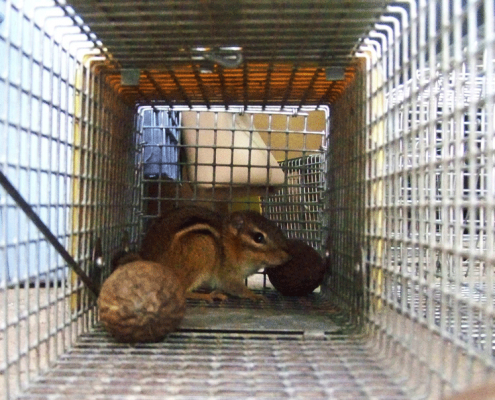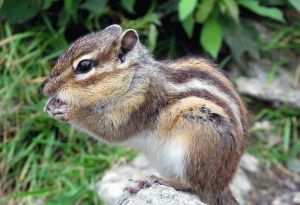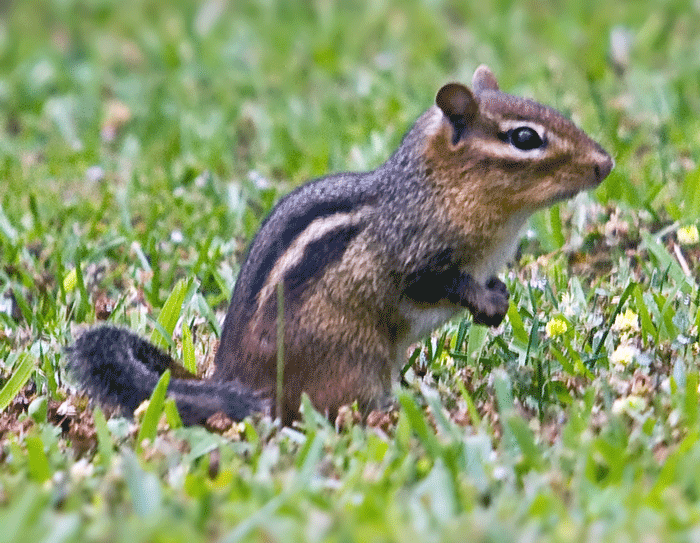
Chipmunks are one of the many types of animals that might be messing around in your backyard or roof. They, like other rodents, can be difficult to deal with while also having their own particular sets of challenges when attempting to find or get rid of them. Chipmunks are quick, agile, and very efficient which means that when left to their own devices, can be very problematic to have around your house or yard. Below are the main ways to identify a Chipmunk.
Chipmunks solutions
Chipmunk Description
Chipmunks are rodents and a member of the squirrel family. They are very similar looking to squirrels, while having some key differences, and being smaller in size overall. They are the smallest type of squirrel in the group with a length of about 11 inches. They are slightly chubby, with a weight of around 4 ounces. They are covered in fur, have stubby legs, and big bushy tails. Their tails individually tend to reach lengths of 5 inches which is about half of their overall size in length. They are most commonly identified by the long black, brown, and white stripes running down the back of their body.
Chipmunks are smaller animals so their tracks tend to be sized appropriately. They have distinct looking tracks but due to their size they can sometimes be hard to discern or even find at all. Their primary method of movement tends to be by bounding. Bounding is the act where an animal essentially jumps forward over and over again using all of its limbs at the same time. This means that chipmunk footprints tend to be a line of four print clusters as they move from one location to another. They don’t always do this though, which could complicate things.
On the other hand, it’s helpful because if you do see bounding prints, then it must be either a chipmunk or squirrel since other bounding creatures, such as weasels or otters, would be much rarer to find in the average backyard. Their fingers are also thinner and the middle part between the palm and the tip tends to not show up very well on most surfaces. They also have little claw mark indentations at the tip of each finger’s tracks.
Chipmunks tend to be a bit hard to track through their feces due to similar reasons as their sounds as explained in the next section. Basically, chipmunk droppings tend to be very similar to that of a mouse’s, which makes it hard for the untrained eye to try and figure out exactly what sort of creature they are dealing with. Chipmunk feces, like mice feces, are oblong with a very similar length, color, and thickness. One difference is that chipmunk droppings are a tiny bit larger overall. The little pellets have a very consistent dark color.
Homeowners should always be very careful not to interact with the animals’ droppings directly as chipmunk feces are just as toxic and dangerous as that of mice and other rodents. Chipmunks will usually drop their feces in one particular spot, unlike mice which tend to leave them scattered, which is one of the better ways to differentiate between the two. Chipmunk droppings will harden and become very brittle over time.
Chipmunks are different from other types of rodents and pests in that they don’t really make as much noise as would be expected of a creature like this. They tend to be quiet, although not completely, most of the time. This can make them hard to find when they are foraging outside or even when entering a person’s home or attic. Of course, their movements and damage they cause cannot be completely silent, so they can still be relatively annoying to have to deal with on your roof and inside your ceiling.
When they do make natural noises though, they are actually very similar to bird calls which makes them notoriously difficult to track and pinpoint by sound. Most of the time they are confused for birds which leave homeowners having to look for other ways to figure out what sort of creature they are dealing with. The noises they make are actually social communicators to let other nearby chipmunks be aware of potential threats. They have a specific noise for natural hunters such as cats and foxes, while interestingly enough, having a completely different, dimmer sound, for flying threats such as hawks.
Chipmunks are small animals that tend to feed on simple things such as nuts, buds, and smaller fruits. They can also eat grass and similar foliage, but this does not make them herbivores as they are more than capable of consuming and even hunting for animal food. They can be predatory and opportunistic as they consume smaller creatures such as worms and insects, as well as, slightly bigger ones like frogs and even bird eggs. This makes them dangerous around a bird population as they can, and will, eat everything from unhatched eggs to even baby birds. They will also loiter around bird feeders and nests to try and steal some of their seeds.
They mainly acquire their food by foraging with some exceptions. Acquired from humans, they can also eat grains and some vegetables when given to them. Of course, they can also steal these foods for themselves which makes them considered as pests in many places dealing with food and trade. Once autumn comes around they, like other similar animals, will begin to stockpile foods to prepare for winter. Mainly they do this by storing them in relatively large underground burrows. They carry their food around in their trademark cheek pouches.
 Chipmunks are small animals, and although they can’t do much major damage by themselves, they can still have many annoying behaviors. Larger groups could pose bigger problems. Overall, chipmunks tend to stay out of people’s homes most of the time so they probably won’t be nesting in your attic like other animals tend to do. Instead, they focus on building up their burrows and nests by foraging the surrounding areas for supplies. This is where the main brunt of their damage comes from as they can be very carefree when they rummage around and certainly don’t mind tearing up a few lawns to get what they want.
Chipmunks are small animals, and although they can’t do much major damage by themselves, they can still have many annoying behaviors. Larger groups could pose bigger problems. Overall, chipmunks tend to stay out of people’s homes most of the time so they probably won’t be nesting in your attic like other animals tend to do. Instead, they focus on building up their burrows and nests by foraging the surrounding areas for supplies. This is where the main brunt of their damage comes from as they can be very carefree when they rummage around and certainly don’t mind tearing up a few lawns to get what they want.
The biggest indicators of chipmunks and their damage include:
Holes in Gardens:
Chipmunks set up their nests and food piles underground which means that you might end up with a large number of holes in your lawn should chipmunks decide to set up camp there. Obviously this can be very problematic as your flower beds or other similar garden features get torn up or rummaged through by burrowing chipmunks.
Garden & Flower Damage:
And because they might already be trying to set up a nest near or on your lawn, there’s nothing stopping chipmunks from trying to steal your seeds and flower bulbs as well. They can easily cause damage faster to your garden than you could repair if allowed to get out of hand.
Structural Damage:
Similar to garden damage, if a chipmunk decides to build its burrow close to your house then it may be affecting the foundation of your house or similar nearby buildings. This could cause problems later on if the damage gets worse either through flooding or by being further exploited by other bigger animals. You don’t want chipmunks nesting and digging too close to your house.
Restless Birds:
Chipmunks will try to forage their food out of any place they can. So not only does this mean that they might try to steal from you and your garden, but they are also more than willing to try and steal from other animals. They especially tend to focus on birds as their nests sometimes drop food and seeds from high above, down onto a pile underneath a tree or feeder. This means that chipmunks will constantly loiter around any nearby birds trying to take as much as they can from them. Birds will of course be annoyed by this which can lead to more chaotic behavior on part of the birds themselves, as well as the chipmunks. These escalations can quickly become tiresome to nearby humans.
Chipmunk Tracks:
Chipmunks are fast runners and bounders who try to cover as much distance as they can as they explore and search for food. This means that you can end up with a lot of tracks scattered throughout your lawn which can be difficult to clean up or remove.
All in all, while not the most chaotic or dangerous of animals, chipmunks can still be a nuisance if not handled quickly and properly.
 Chipmunks might be small, cute and generally nonviolent but that doesn’t mean there are no risks associated with them. As with any wild animal, precautions must be taken when near one to avoid risking injury or disease. If you encounter any such animal setting up a nest in your residence then you should look for a nearby professional to help you manage and remove them. If left to their own devices they can cause serious damage to your house or property.
Chipmunks might be small, cute and generally nonviolent but that doesn’t mean there are no risks associated with them. As with any wild animal, precautions must be taken when near one to avoid risking injury or disease. If you encounter any such animal setting up a nest in your residence then you should look for a nearby professional to help you manage and remove them. If left to their own devices they can cause serious damage to your house or property.
The most commonly associated risks involving wild chipmunks are:
Physical Injury:
Chipmunks are generally peaceful and aside from loitering and stealing from humans and other animals, they’ll generally keep to themselves and try to avoid any confrontation. But of course, like with any animal, they can and will defend themselves aggressively if cornered and left without a way to escape. They can bite and claw at you with their sharp teeth and nails which can be very painful, as well as, being very likely to cause some sort of sickness later on. Chipmunks are best left undisturbed and homeowners should rely on professionals to handle them carefully.
Disease:
Chipmunks are a part of the rodent family. This makes them dangerous to interact with as they have been known to carry a multitude of diseases such as rabies. Children should be kept far away from them to prevent any attack or other type of contact.
Feces:
Their feces is very similar to that of mice not just in shape and size but in toxicity as well. Chipmunk feces are extremely poisonous to humans and should be stayed far away from. If you see any type of animal feces in your home, you should immediately contact a professional to safely remove it. Animal droppings are also a likely sign of an animal taking up residence in or near your house and lawn.
House & Lawn Damage:
Chipmunks, like other similar animals are capable of getting inside your house and causing problems. Unlike other pests, they very rarely try to set up a nest inside your roof or attics, like squirrels or bats do. Instead they will try to dig a burrow in your lawn which will lead to a quickly ruined garden. They will dig up flowers, steal seeds and generally try to stock up on anything they can find for their nest. This can make them extremely bothersome to deal with.
Animal or Environmental Damage:
Chipmunks try to hoard a lot of food. A single chipmunk is capable of collecting more than 100 acorns a day which means that they are more than capable of disrupting the lives of not only humans but everyday animals living nearby. They can bother and attempt to steal from any of your pets as well as from nearby birds. This will agitate animals and could cause problems as the other creatures start to exhibit their own problematic behaviors in response. They can also cover large sections of grass with tracks and marks.
